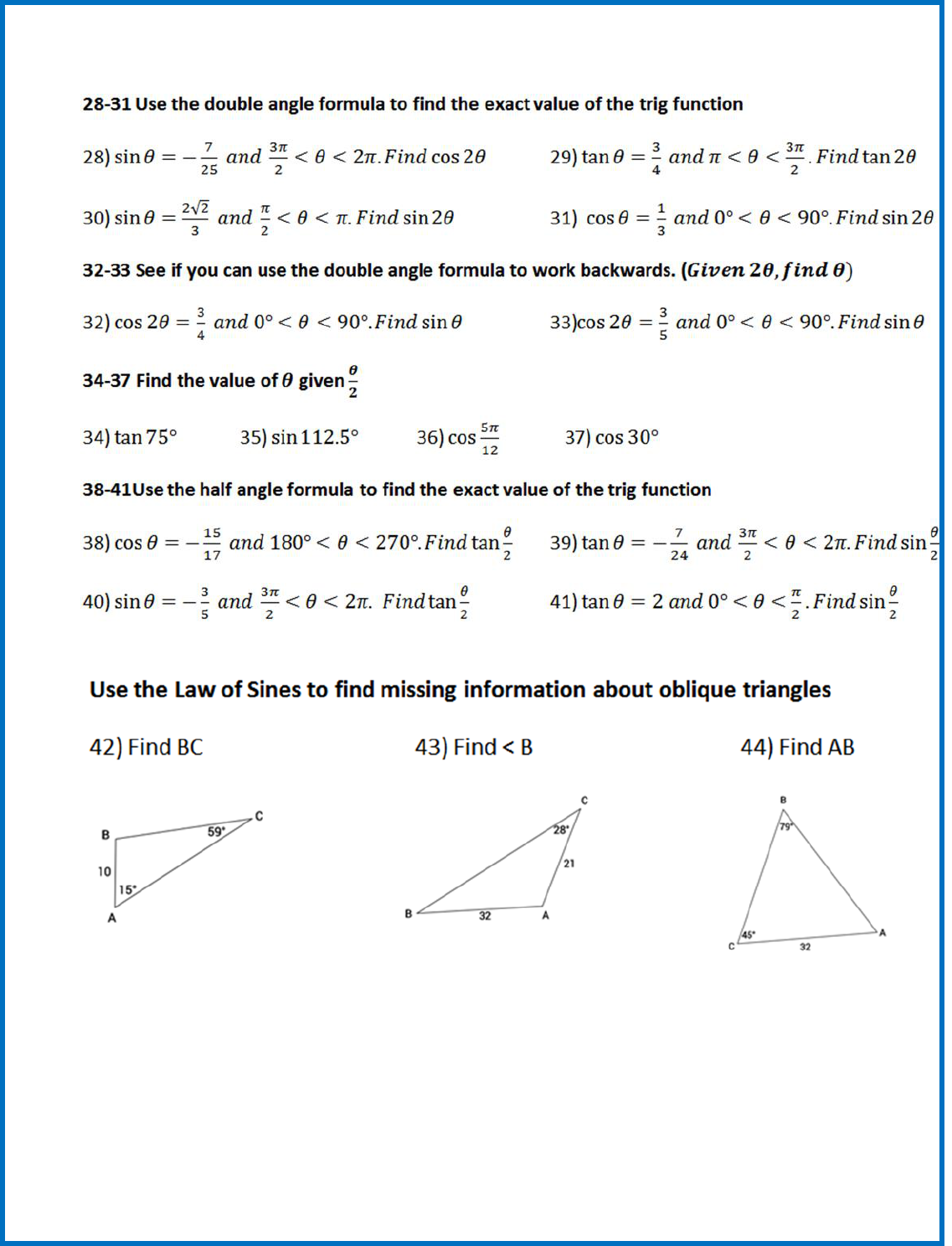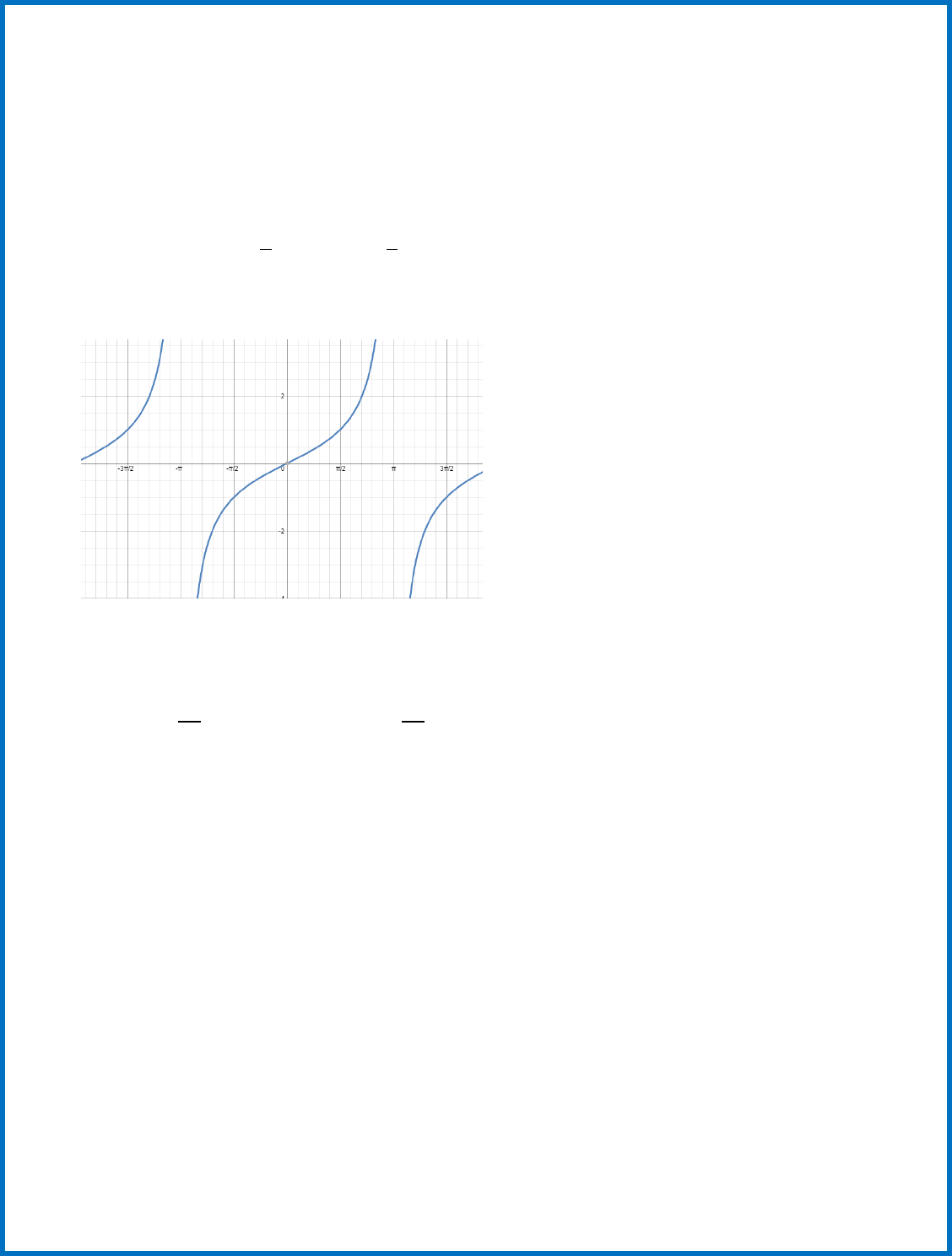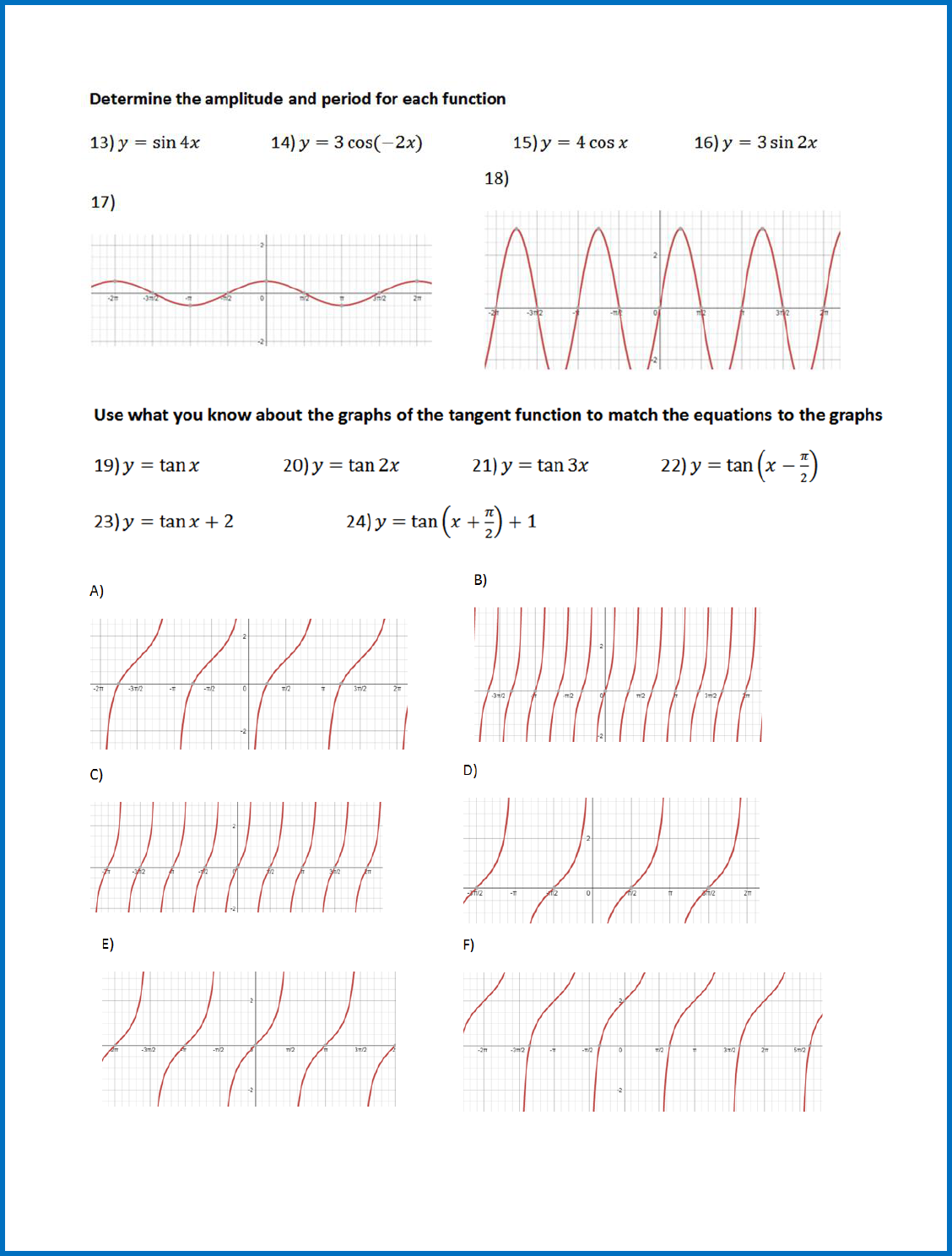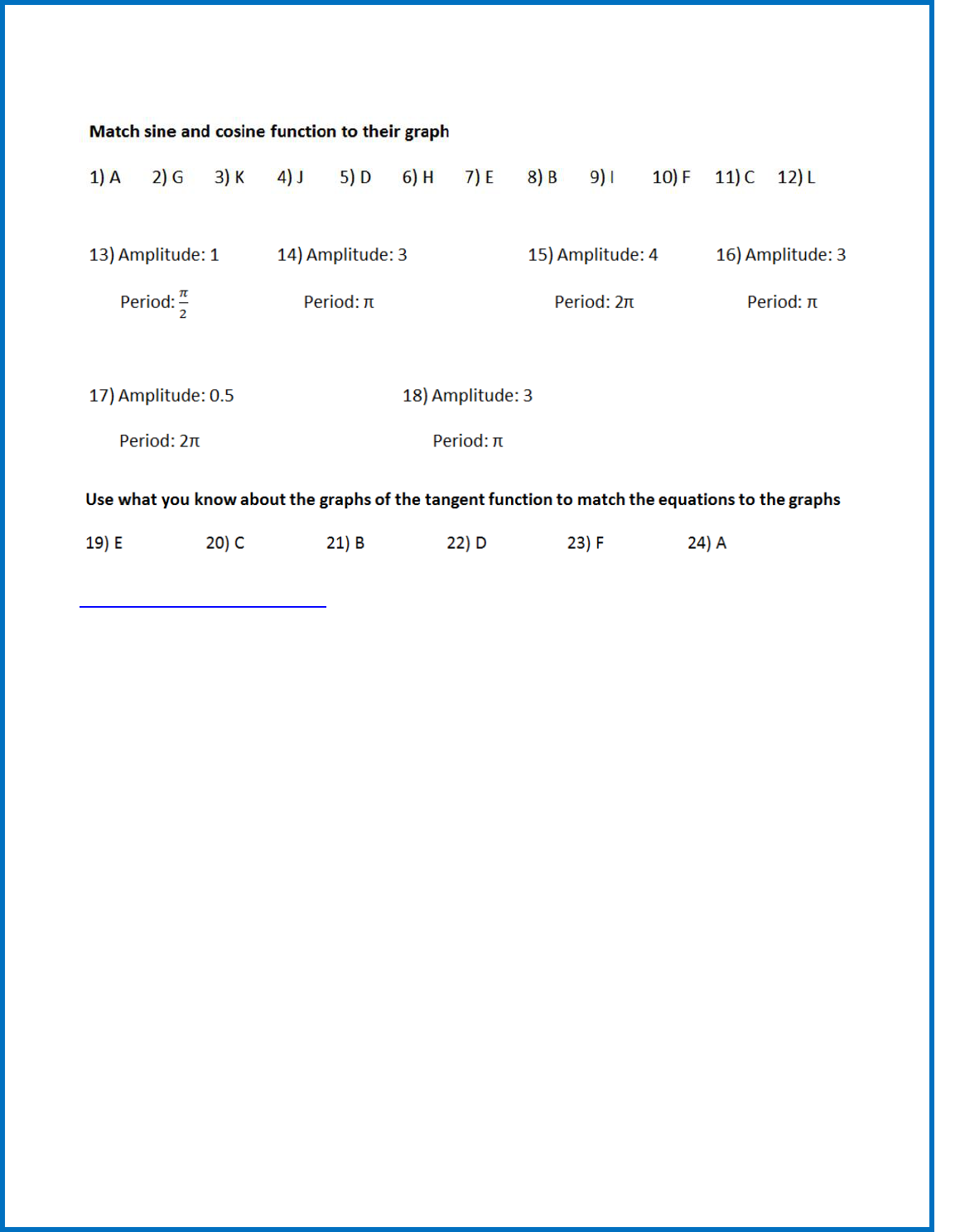
1
Trigonometry
An Overview of
Important Topics

2
Contents
Trigonometry – An Overview of Important Topics ....................................................................................... 4
UNDERSTAND HOW ANGLES ARE MEASURED ............................................................................................. 6
Degrees ..................................................................................................................................................... 7
Radians ...................................................................................................................................................... 7
Unit Circle .................................................................................................................................................. 9
Practice Problems ............................................................................................................................... 10
Solutions.............................................................................................................................................. 11
TRIGONOMETRIC FUNCTIONS .................................................................................................................... 12
Definitions of trig ratios and functions ................................................................................................... 12
Khan Academy video 2 ........................................................................................................................ 14
Find the value of trig functions given an angle measure ........................................................................ 15
Find a missing side length given an angle measure ................................................................................ 19
Khan Academy video 3 ........................................................................................................................ 19
Find an angle measure using trig functions ............................................................................................ 20
Practice Problems ............................................................................................................................... 21
Solutions.............................................................................................................................................. 24
USING DEFINITIONS AND FUNDAMENTAL IDENTITIES OF TRIG FUNCTIONS ............................................. 26
Fundamental Identities ........................................................................................................................... 26
Khan Academy video 4 ........................................................................................................................ 28
Sum and Difference Formulas ................................................................................................................. 29
Khan Academy video 5 ........................................................................................................................ 31
Double and Half Angle Formulas ............................................................................................................ 32
Khan Academy video 6 ........................................................................................................................ 34
Product to Sum Formulas ....................................................................................................................... 35
Sum to Product Formulas ....................................................................................................................... 36
Law of Sines and Cosines ........................................................................................................................ 37
Practice Problems ............................................................................................................................... 39
Solutions.............................................................................................................................................. 42
UNDERSTAND KEY FEATURES OF GRAPHS OF TRIG FUNCTIONS ................................................................ 43
Graph of the sine function ................................................................................................ 44
Graph of the cosine function ............................................................................................ 45

3
Key features of the sine and cosine function.......................................................................................... 46
Khan Academy video 7 ........................................................................................................................ 51
Graph of the tangent function ......................................................................................... 52
Key features of the tangent function ...................................................................................................... 53
Khan Academy video 8 ........................................................................................................................ 56
Graphing Trigonometric Functions using Technology ............................................................................ 57
Practice Problems ............................................................................................................................... 60
Solutions.............................................................................................................................................. 62
Rev. 05.06.2016-4

4
Trigonometry – An Overview of Important Topics
So I hear you’re going to take a Calculus course? Good idea to brush up on your
Trigonometry!!
Trigonometry is a branch of mathematics that focuses on relationships between
the sides and angles of triangles. The word trigonometry comes from the Latin
derivative of Greek words for triangle (trigonon) and measure (metron).
Trigonometry (Trig) is an intricate piece of other branches of mathematics such
as, Geometry, Algebra, and Calculus.
In this tutorial we will go over the following topics.
Understand how angles are measured
o Degrees
o Radians
o Unit circle
o Practice
Solutions
Use trig functions to find information about right triangles
o Definition of trig ratios and functions
o Find the value of trig functions given an angle measure
o Find a missing side length given an angle measure
o Find an angle measure using trig functions
o Practice
Solutions
Use definitions and fundamental Identities of trig functions
o Fundamental Identities
o Sum and Difference Formulas
o Double and Half Angle Formulas
o Product to Sum Formulas
o Sum to Product Formulas
o Law of Sines and Cosines
o Practice
Solutions

6
UNDERSTAND HOW ANGLES ARE MEASURED
Since Trigonometry focuses on relationships of sides and angles of a triangle, let’s
go over how angles are measured…
Angles are formed by an initial side and a terminal side. An initial side is said to
be in standard position when it’s vertex is located at the origin and the ray goes
along the positive x axis.
An angle is measured by the amount of rotation from the initial side to the
terminal side. A positive angle is made by a rotation in the counterclockwise
direction and a negative angle is made by a rotation in the clockwise direction.
Angles can be measured two ways:
1. Degrees
2. Radians

7
Degrees
A circle is comprised of 360°, which is called one revolution
Degrees are used primarily to describe the size of an angle.
The real mathematician is the radian, since most computations are done in
radians.
Radians
1 revolution measured in radians is 2π, where π is the constant approximately
3.14.
How can we convert between the two you ask?
Easy, since 360° = 2π radians (1 revolution)
Then, 180° = π radians
So that means that 1° =
radians

8
And
degrees = 1 radian
Example 1
Convert 60° into radians
60 (1 degree)
= 60
=
radian
Example 2
Convert (-45°) into radians
-45
=
radian
Example 3
Convert
radian into degrees
(1 radian)
=
=
= 270°
Example 4
Convert
radian into degrees
Before we move on to the next section, let’s take a look at the Unit Circle.

9
Unit Circle
The Unit Circle is a circle that is centered at the origin and always has a radius of
1. The unit circle will be helpful to us later when we define the trigonometric
ratios. You may remember from Algebra 2 that the equation of the Unit Circle is
Need more help? Click below for a Khan Academy video
Khan Academy video 1

10
Practice Problems

12
TRIGONOMETRIC FUNCTIONS
Definitions of trig ratios and functions
In Trigonometry there are six trigonometric ratios that relate the angle measures
of a right triangle to the length of its sides. (Remember a right triangle contains a
90° angle)
A right triangle can be formed from an initial side x and a terminal side r, where r
is the radius and hypotenuse of the right triangle. (see figure below) The
Pythagorean Theorem tells us that x² + y² = r², therefore r =
. (theta) is
used to label a non-right angle. The six trigonometric functions can be used to
find the ratio of the side lengths. The six functions are sine (sin), cosine (cos),
tangent (tan), cosecant (csc), secant (sec), and cotangent (cot). Below you will see
the ratios formed by these functions.
sin =
, also referred to as
cos =
, also referred to as
tan =
, also referred to as
These three functions have 3 reciprocal functions
csc =
, which is the reciprocal of sin

13
sec =
,which is the reciprocal of
cot =
, which is the reciprocal of
You may recall a little something called SOH-CAH-TOA to help your remember the
functions!
SOH… Sine = opposite/hypotenuse
…CAH… Cosine = adjacent/hypotenuse
…TOA Tangent = opposite/adjacent
Example: Find the values of the trigonometric ratios of angle
Before we can find the values of the six trig ratios, we need to find the length of
the missing side. Any ideas? Good call, we can use r =
(from the
Pythagorean Theorem)
r =
=
=
= 13
Now we can find the values of the six trig functions
sin θ =
=
csc θ =
=
cos θ =
=
sec θ =
=
tan θ =
=
cot θ =
=

14
Example 5
a) Use the triangle below to find the six trig ratios
Example 6
Use the triangle below to find the six trig ratios
Need more help? Click below for a Khan Academy Video
Khan Academy video 2
First use Pythagorean Theorem to find the hypotenuse
a² + b² = c², where a and b are legs of the right triangle and c is the
hypotenuse
=

15
Find the value of trig functions given an angle measure
Suppose you know the value of is 45°, how can this help you find the values of
the six trigonometric functions?
First way: You can familiarize yourself with the unit circle we talked about.
An ordered pair along the unit circle (x, y) can also be known as (cos , sin ),
since the r value on the unit circle is always 1. So to find the trig function values
for 45° you can look on the unit circle and easily see that sin 45° =
, cos =
With that information we can easily find the values of the reciprocal functions
csc 45° =
=
=
, sec 45° =
We can also find the tangent and cotangent function values using the quotient
identities

16
tan 45° =
=
= 1
cot 45° = 1
Example 7
Find
=
Example 8
Find
Example 9
Find
Using this method limits us to finding trig function values for angles that are
accessible on the unit circle, plus who wants to memorize it!!!
Second Way: If you are given a problem that has an angle measure of 45°, 30°, or
60°, you are in luck! These angle measures belong to special triangles.
If you remember these special triangles you can easily find the ratios for all the
trig functions.
Below are the two special right triangles and their side length ratios

17
How do we use these special right triangles to find the trig ratios?
If the θ you are given has one of these angle measures it’s easy!
Example 10 Example 11 Example 12
Find Find Find
Third way: This is not only the easiest way, but also this way you can find trig
values for angle measures that are less common. You can use your TI Graphing
calculator.
First make sure your TI Graphing calculator is set to degrees by pressing mode

18
Next choose which trig function you need
After you choose which function you need type in your angle measure
Example 13 Example 14 Example 15
0.5736

19
Find a missing side length given an angle measure
Suppose you are given an angle measure and a side length, can you find the
remaining side lengths?
Yes. You can use the trig functions to formulate an equation to find missing side
lengths of a right triangle.
Example 16
Let’s see another example,
Example 17
Need more help? Click below for a Khan Academy video
Khan Academy video 3
First we know that
therefore
Next we solve for x,
Use your TI calculator to compute
And you find out
We are given information about the opposite and adjacent
sides of the triangle, so we will use tan

20
Find an angle measure using trig functions
Wait a minute, what happens if you have the trig ratio, but you are asked to find
the angles measure? Grab your TI Graphing calculator and notice that above the
sin, cos, and tan buttons, there is
,
,
. These are your inverse
trigonometric functions, also known as arcsine, arccosine, and arctangent. If you
use these buttons in conjunction with your trig ratio, you will get the angle
measure for !
Let’s see some examples of this.
Example 18
How about another
Example 19
We know that
So to find the value of θ, press 2
nd
tan on your calculator
and then type in (8/6)
We are given information about the adjacent side and the
hypotenuse, so we will use the cosine function

21
Practice Problems

22

23

24
Solutions

26
USING DEFINITIONS AND FUNDAMENTAL IDENTITIES OF TRIG
FUNCTIONS
Fundamental Identities
Reciprocal Identities
sin = 1/(csc ) csc = 1/(sin )
cos = 1/(sec ) sec = 1/(cos )
tan = 1/(cot ) cot = 1/(tan )
Quotient Identities
tan = (sin )/(cos ) cot = (cos )/(sin )
Pythagorean Identities
sin² + cos² = 1
1+ tan² = sec²
1+ cot² = csc²
Negative Angle Identities
Complementary Angle Theorem
If two acute angles add up to be 90°, they are considered complimentary.
The following are considered cofunctions:
sine and cosine tangent and cotangent secant and cosecant
The complementary angle theorem says that cofunctions of complimentary
angles are equal.

27
Example 20)
How can we use these identities to find exact values of trigonometric functions?
Follow these examples to find out! Examples 21-26
21) Find the exact value of the expression
Solution: Since
22) Find the exact value of the expression
Solution: Since
23)
Solution:
24)
Solution:
25)
, find , where is in quadrant II
Solution: Pick an identity that relates cotangent to cosecant, like the
Pythagorean identity 1 + cot² = csc² .
1 +
= csc² θ
1 +
= csc²
csc²
csc
The positive square root is chosen because csc is positive in quadrant II

29
Sum and Difference Formulas
In this section we will use formulas that involve the sum or difference of two
angles, call the sum and difference formulas.
Sum and difference formulas for sines and cosines
How do we use these formulas?
Example 27 Find the exact value of
Well we can break 105° into 60° and 45° since those values are relatively easy to
find the cosine of.
Therefore =
Using the unit circle we obtain,
=
=
Example 28 Find the exact value of

30
Sum and difference formulas for tangent
Example 29 Find the exact value of
=
(rationalize the denominator)
Example 30 Find
=
Cofunction Identities
Example 31
Find

32
Double and Half Angle Formulas
Below you will learn formulas that allow you to use the relationship between the
six trig functions for a particular angle and find the trig values of an angle that is
either half or double the original angle.
Double Angle Formulas
cos² sin² =cos² sin²
Half Angle Formulas
Lets see these formulas in action!
Example 32 Use the double angle formula to find the exact value of each
expression

33
Example 33
,
First we need to find what the is. We know that is opposite leg over
adjacent leg, so we need to find the hypotenuse since cos is adjacent over
hypotenuse. We can use
to find the length of the
hypotenuse. Now we know the
. Now use the double angle formula to
find .
We take the positive answer since is in the third quadrant making the ratio a
negative over a negative.
Now lets try using the half angle formula
Example 34
Choose the positive root
Example 35
and
First we use the Pythagorean Theorem to find the third side

35
Product to Sum Formulas
Example 36 Use the product-to-sum formula to change to a sum

36
Sum to Product Formulas
Example 37 Use the sum-to-product formula to change into a
product

37
Law of Sines and Cosines
These laws help us to find missing information when dealing with oblique
triangles (triangles that are not right triangles)
Law of Sines
You can use the Law of Sines when the problem is referring to two sets of angles
and their opposite sides.
Example 38 Find the length of AB. Round your answer to the nearest tenth.
Law of Cosines
You can use the Law of Cosines when the problem is referring to all three sides
and only one angle.
Since we are given information about an angle, the side opposite of
that angle, another angle, and missing the side opposite of that angle,
we can apply the Law of Sines.
Multiply both sides by the common denominator in order to eliminate
the fractions. We do this so that we can solve for the unknown. This
gives us,
Then we can divide by. When we do this we find

38
Example 39 Find the length of AB. Round to the nearest tenth.
Since all three sides of the triangle are referred to and information about one
angle is given, we can use the Law of Cosines.
Since AB is opposite of <C, we will call it c and use the following formula,

39
Practice Problems

40

41

43
UNDERSTAND KEY FEATURES OF GRAPHS OF TRIG FUNCTIONS
In this section you will get a brief introduction to the graphs of the three main trig
functions, sine, cosine, and tangent. This section will not go over how to actually
graph these functions, but will go over how to identify key features of the graphs
of each function.
The graphs of sine and cosine are considered periodic functions, which basically
means their values repeat in regular intervals known as periods.
A periodic function is a function f such that
We talked about the fact that one revolution of the unit circle is 2π radians, which
means that the circumference of the unit circle is 2π. Therefore, the sine and
cosine function have a period of 2π.

44
Graph of the sine function
If you notice, the range of the sine function is [-1, 1] and the domain is
(-∞, ∞)
Also notice that the x-intercepts are always in the form nπ. Where n is an
integer
This is an odd function because it is symmetric with respect to the origin
The period is 2π because the sine wave repeats every 2π units

45
Graph of the cosine function
• If you notice, the range of the cosine function is [-1, 1] and the domain is
(-∞, ∞)
• This is an even function because it is symmetric with respect to the y axis
therefore for all cos( -x ) = cos (x)
The period is also 2π because the cosine wave repeats every 2π units

46
Key features of the sine and cosine function
Amplitude measures how many units above and below the midline of the graph
the function goes. For example, the sine wave has an amplitude of 1 because it
goes one unit up and one unit down from the x-axis.
Y = a sin x
AMPLITUDE:
a is the amplitude. The graph of y = a sin x and y = a cos x, where a≠0 will have a
range of [-|a|, |a|]
Below is the graph of y = sin x

47
What happens if you change the amplitude to 2? Below is the graph of y = 2 sin x.
You see how the graph stretched up right? Now the range is [-2, 2] instead of [-1,
1].
What do you think would happen if you changed the amplitude to ½? Or 3?
Check it out below
Does this happen with cosine as well? Recall the graph of y = cos x

48
Now lets take a look at y = 2 cos x
We can conclude that the amplitude vertically stretches or shrinks both the sine
and cosine graphs. Notice that when the amplitude was changed the function still
repeats every 2π units, therefore the amplitude does not affect the period of the
function.
PERIOD
Again lets look at the graph of y = sin x
Notice how the graph changes when we change the function to y = sin 2x

49
Did you notice that the sine wave repeats every π units now instead of every 2π
units? This means the function is finishing its cycle twice as fast, which means its
period is half as long. If you consider the function y = a sin bx, the b value affects
the period of the function. It will horizontally stretch or squish the graph.
Think about what the graph would look like if you changed it to y = sin 0.5x.
There is a general formula used to find the period (ω) of a sine or cosine function
You will notice that the sine and cosine functions are affected the same by
changes made in the equations, so changing the b value will have the same effect
on the cosine function.
Just to show you, below are the graphs of y = cos x and y = cos 3x

50
PHASE SHIFT
Not only can the graphs be contracted or stretched vertically and horizontally, but
they can also be shifted left and right and up and down. First we will focus on
shifting the graph left and right.
Since the sine function has been getting all the action, lets look at the cosine
function y = cos x
If we change the equation to y = cos
, watch what happens to the graph.
The blue wave is the original y = cos x and the green wave is the y = cos
.
You will notice that the graph was shifted
units to the right. If the equation had
been y = cos
, the graph would have shifted
units to the left. When the
graph is shifted to the left or right it is called a “phase shift”. If you consider the
equation y = a cos (bx – c), the phase shift can be found by taking c/b. Again the
sine function is affected the same.

51
VERTICAL SHIFT
The last way we can alter the sine and cosine functions is by making a vertical
shift. Lets take a look at what happens to the function when we change it to
y = cos x + 3 (Notice the 3 is not in parenthesis)
The blue wave is the original y = cos x and the green wave is the function
y = cos x + 3. When you add a number at the end you shift the graph up that
many units and if you subtract a number at the end you shift the graph down that
many units. When the function is written in the form y = a cos (bx – c) + d, d
controls whether the function will be shifted up or down.
Need more help? Click below for a Khan Academy video
Khan Academy video 7

52
Graph of the tangent function
• If you notice, the range of the tangent function is and the domain
is
• The x intercepts are always in the form of
• The period is
• The tangent will be zero wherever the numerator (sine) is zero
• The tangent will be undefined wherever the denominator (cosine) is zero
• The graph of the tangent function has vertical asymptotes at values of in
the form of
• Since the graph is symmetrical about the origin, the function is an odd
function

53
Key features of the tangent function
AMPLITUDE
Amplitude does not apply to the tangent function since there aren’t any minimum
or maximum values.
PERIOD
Consider the tangent function in the form . To determine the period
use
. Below is the graph of notice that the tangent function repeats
every π units.
Now look if we graph the function
Notice now that the function repeats every
units.

54
VERTICAL ASYMPTOTES
The tangent function has something called vertical asymptotes, which are
invisible vertical lines that the function approaches, but never crosses. To find the
two consecutive vertical asymptotes of a tangent function you can solve the two
equations
and
Consider the graph of the function
You can see from the graph that there are vertical asymptotes at and . You
could have also used the equations to obtain this information.
and

55
PHASE SHIFT
The phase shift for the tangent works the same way as the sine and cosine
function. Consider the graph of the function
The blue is the function and the green is the function
.
Notice that the functions appear the same except
is shifted
units to the right.
VERTICAL SHIFT
Again this works the same for tangent as it did for sine and cosine. Consider the
graph of the function

56
Again the function graphed in blue is the function and the function
graphed in green is As you can see the only difference between
the two graphed functions is that the function is shifted up one
unit.
Need more help? Click below for a Khan Academy video
Khan Academy video 8

57
Graphing Trigonometric Functions using Technology
Graphing a function in your TI-Graphing Calculator is easy!
First type your function into y1
Next you need to change the mode on your calculator to radians. To do this first
press MODE and then scroll down and select Radians.

58
Then press ZOOM and choose option 7 ZTRIG
Once you choose option 7, your function should start to graph!

60
Practice Problems

61









